William-Adolphe Bouguereau Biography
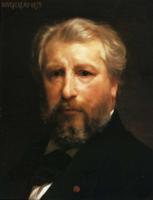
William-Adolphe Bouguereau was born November 30, 1825, in the city of La Rochelle, France. The second son of Théodore Bouguereau, a struggling wine salesman, he was sent off at an early age to stay with his uncle, Eugène Bouguereau, a vicar in the parish of Mortagne-sur-Gironde, to help the family weather some dire financial straits.
Under his uncle's care William got a thorough education in Latin and French literature, as well as religious texts. At the age of fourteen his uncle sent him to study at the college of Pons, a religious boarding school administered by a friend and fellow clergyman. He received his first lessons in artistic drawing from a professor named Louis Sage.
In 1841 Théodore Bouguereau abandoned his wine venture and moved to Bordeaux, where he took up the olive oil trade, with more success. William was requested to leave his studies behind and rejoin his family as a bookkeeper for the business, as a means of training so that he could later take up a salaried bookkeeping job at a different workshop. However, William had his sights set on the local École des Beaux-Arts, a municipal art school, after learning about it from a friend who'd attended. With the help of his friends, his mother, and Eugène, all of whom were aware and supportive of his artistic talents, William convinced his father into giving him permission to enlist in the school, on the condition that these studies wouldn't lead him down the risky path of pursuing a professional art career.
William's outstanding painting skills got him immediately accepted into the senior class at the school, taught by one Jean-Paul Alaux. Bouguereau was only ever a part-time student, having to balance his studies with work in the family business. However, his aptitude with a brush not only let him keep up with his classes, but even won him a prize in 1844 for "Best Historical Painting", despite steep competition from his older, full-time classmates. This strongly encouraged William to pursue further studies at the more prestigious École des Beaux-Arts in Paris. His father reluctantly gave him permission to do so.
Unable to afford the trip, Bouguereau couldn't depart for Paris immediately. To raise money, he enlisted the help of his uncle and moved back to Mortagne-sur-Gironde, where he painted commissions–mostly portraits–for prominent locals. The resulting revenue was enough to let him undertake the journey, and after a brief stay in his hometown, which nearly resulted in his conscription by the French military, he departed for Paris.
Thanks to a letter of recommendation from his professor in Bordeaux, Alaux, William was able to immediately find employment in the studio of François Picot, a widely-known French artist of the time. Work at the studio was allegedly grueling and William struggled to make ends meet while lacking any free time. However, in 1846 he was finally accepted into the École des Beaux-Arts, narrowly making it into their yearly quota of 100 admissions, and began his art studies in earnest. In 1848 he submitted his first entry to the Prix de Rome, an art competition through which he hoped to win a scholarship for a one-year trip to Rome. His first attempt tied for second place with fellow artist Gustav Boulanger, so in 1849 he entered again, but did not place. Finally, in 1850 his entry won the grand prize and he left for Italy.
In Italy, he stayed for a while at the Villa Medici, where Prix winners normally boarded during their stay, studying the works of famous Italian artists such as Titian, Veronese, Michelangelo, Raphael, and Leonardo da Vinci. Then, wanting to broaden his horizons, he began traveling throughout Italy, visiting Naples, Pompeii, Sienna, and Florence, among other cities. Throughout this time, he was required by the school to send back assignments as proof that his trip was being spent productively. Such works included The Jews led into Captivity, Battle of the Centaurs, and The Triumph of the Martyr.
After his stay in Italy, Bouguereau returned to France, where his professional career began with several commissions for some wealthy relatives living in La Rochelle. Around 1856 he moved to Paris, where he married Marie-Nelly Monchablon. He was then hired to decorate the drawing rooms of the Hôtel Custine. The son of the owner, Anatole Bartholoni, was impressed by the artist's work and invited him to decorate the drawing rooms of his own mansion, where Bouguereau's paintings were first seen by Théophile Gauthier, a famous contemporary writer and poet. Théophile praised Bouguereau in his art column, which helped further spread word of the young artist's talent. The Salon of 1857, a prestigious Parisian art exhibition, awarded Bouguereau the Medal of Honor for his work on the Bartholoni properties. This caught the attention of the French Emperor Napoleon III, who commissioned several paintings from Bouguereau that same year, including portraits of himself and the Empress Eugénie.
This solidified Bouguereau's fame, and for the next several years he enjoyed the patronage of wealthy French aristocrats and businessmen, including a lengthy project to decorate the mansion of a banker which took two years to complete. He later took part in the decoration of the St. Louis Chapel in the Basilica of Saint Clotilde and painted one of his better known canvases, All Souls Day (1859), which was sold to the city of Bourdeaux. Around this time he was made Chevalier of the National Order of the Legion of Honor, and became father to two daughters, Henriette and Jeanne, and a son, Georges.
Between 1861 and 1863 Bouguereau's productivity lapsed briefly, possibly in part due to a change in technique the artist was trying to master. However, he still managed to execute over a dozen paintings, including Holy Family (1863), which was purchased by Napoleon III as a gift to his wife. In 1865 he was commissioned to decorate the concert hall in the Grand Théâtre de Bordeaux, although he was unable to begin work there until 1869 due to ongoing construction. In 1866, his younger daughter, Jeanne, passed away at the age of five.
In 1868 Bouguereau and his family moved into a new house, designed for them by William's friend and pupil, Jean Louis Pascal, where they had their fourth child, Paul. However, their stay there was interrupted by the outbreak of the Franco-Prussian War in 1870. Luckily, the family was vacationing in Concarneau, Brittany at the time, and William sent them away to La Rochelle while he returned to Paris alone. The war swiftly turned in favor of the Prussians, and within two months of its beginning Napoleon III had been captured and Paris was besieged. Although he was exempt from military service due to his age, Bouguereau chose to volunteer for the National Guard militia to help the city's defenses. Paris fell in January of the following year, but fortunately both Bouguereau and his home were spared any harm.
He traveled to La Rochelle to reunite with his family, where he resumed his painting career and helped decorate a chapel at the local cathedral. The Bouguereaus moved back to the capital several months later, and about a year hence William took up work as a part-time teacher at the Académie Julian, a famous art school for aspiring painters. He participated in the World Fair of 1873, held in Vienna, as a member of the jury, as well as to exhibit two of his paintings, Seduction and The Spinning Maid.
In 1875 the Bouguereaus were dealt a heavy blow when their elder son, Georges, died at the age of sixteen of a fever. This tragic event was likely the inspiration for two religious works William painted around this time: Pietà (1876) and Virgin the Comforter (c. 1875). That same year he was offered a permanent position at the Académie Julian, and the following year was finally accepted as a member of the Académie des Beaux-Arts, a position he had long sought, as well as being promoted to Officer in the Legion of Honor.
In 1877, his wife gave birth to their third son, Maurice, and, unfortunately, died not long after from tuberculosis and complications she suffered during childbirth. The child passed away a couple of months later. Not too long after his wife's death, Bouguereau began a relationship with one of his pupils, Elizabeth Jane Gardner, but opposition from his remaining family, in particular his mother and daughter, forced him to postpone marrying her, though they became secretly engaged in 1879.
The following years saw Bouguereau devote a lot of time to various art organizations and exhibitions. Around 1881 he was elected the first president in charge of painting in the newly-formed Société des Artistes Français, an association created to oversee the yearly Salon art exhibitions, and in 1885 he became president of the Taylor Foundation, a mutual-help society for artists. That same year he was promoted Commander of the National Order of the Legion of Honor. Following vehement disagreements with fellow artists over regulations concerning the World Fair, Bouguereau resigned from his post at the Société des Artistes Français in 1889, which resulted in a schism that gave rise to a rival association, the Société Nationale des Beaux-Arts. In 1892 William organized an exhibition of French art in London, which proved so popular that it became a regular event.
In 1896, Bouguereau's mother died, leaving him free to finally marry Elizabeth Jane Gardner, with whom he moved back to La Rochelle for a short period of time. Four years later, in 1899, they moved to Menton on the southern coast to be with William's remaining son, Paul, by then a well-known barrister and military officer, who had contracted tuberculosis and was staying there on his doctor's advice. The following year, the Bouguereaus returned to Paris, where Paul died from consumption, leaving William with only one surviving child, Henriette. Although the death was a terrible tragedy for him, Bouguereau continued tending to his many duties in the city, perhaps because they helped keep his mind off the loss. However, this final loss was the last straw which, combined with the never-ending burden of work and his smoking habit, took its toll. His health fell into sharp decline following Paul's passing.
In 1903 he was invited to Italy to attend the 100th anniversary of the Villa Medici, after which he spent a short time in Florence with his wife. This was one of the last big invitations Bouguereau would accept, as he was becoming increasingly weak, to the point of being unable to hold a pencil or paintbrush, let alone walk. Also that year, he was given the rank of Grand Officer of Legion of Honor.
In 1905, wanting to spend the end of his days in his hometown, Bouguereau departed Paris and traveled to La Rochelle. There, he died shortly afterwards on August 23 of that year.
Bibliography
Bouguereau by Fronia E. Wissman. Pomegranate Communications, 1997.
William Bouguereau: His Life and Works by Damien Bartoli. Antique Collectors Club Dist, 2014.
- Saint Louis Rendering Justice.

1859. Mural. 167 x 292 cm. Chapel of Saint Louis, Church of Sainte-Clotilde, Paris, France.
- Le Jour Des Morts (All Saints' Day).
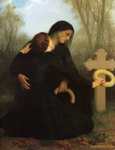
1859. Oil on canvas. 147 x 120 cm. Musée des Beaux-Arts, Bordeaux, France.
- Pieta.

1876. Oil on canvas. Private collection.
- Virgin Of Consolation.
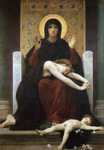
1877. Oil on canvas. Musee des Beaux-Arts, Strasbourg, France.
- Zenobia Found By Shepherds On The Banks Of The Araxes.
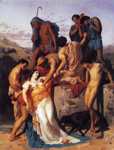
1850. Oil on canvas. 147 x 113 cm. Ecole nationale supérieure des Beaux-Arts, Paris, France.
- Fraternal Love.
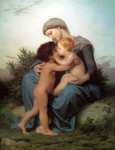
1851. Oil on canvas. 147 x 113.8 cm. The Museum of Fine Arts, Boston, MA, USA.
- Arion On A Seahorse.

1854. Oil on canvas. 71 x 112 cm. Museum of Art, Cleveland, OH, USA.
- Bacchante On A Panther.

1854. Oil on canvas. 71 x 112 cm. Museum of Art, Cleveland, OH, USA.
- L'Amour (Love).

1855. Oil on canvas. 269 x 150 cm. Private collection.
- La Fortune (Fortune).

1855. Oil on canvas. 269 x 150 cm. Private collection.
- L'Amitie (Friendship).

1855. Oil on canvas. 269 x 150 cm. Private collection.